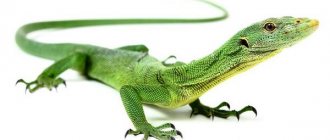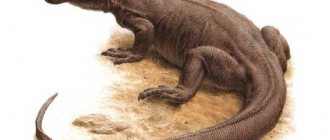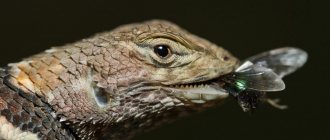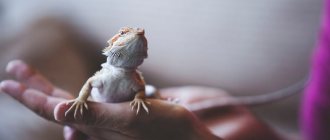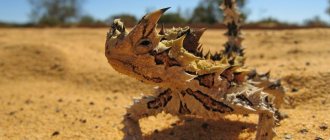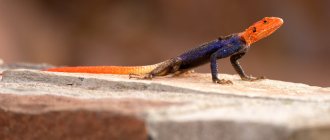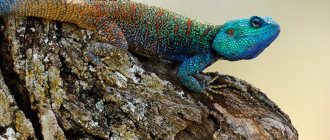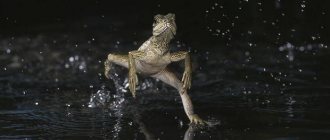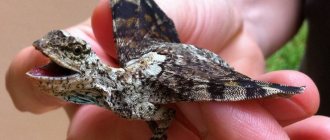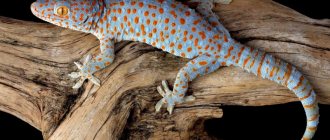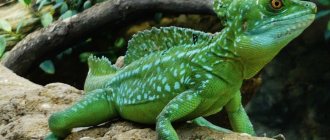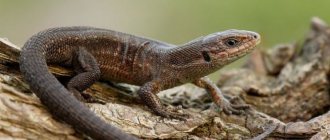Lizards are perhaps the most common animal species on earth. They are found on all continents and continents, except Antarctica. These are, in addition, the most ancient creatures living on our planet. In Japan, for example, the remains of an ancient herbivorous lizard were found, 130 million years old, and a fossil reptile found in Scotland, which was identified as a lizard, has an even more respectable age - 340 million years!
In the article we will look at these amazing descendants of dinosaurs, find out how lizards reproduce, and much more interesting things.
Why lizards are reptiles
To date, about 9,400 representatives of the reptile class are known, and one of them is the lizard. Anyone who watched how this nimble creature moved probably already understood why it belongs to the named class. The lizard, like its other relatives: snakes, turtles or crocodiles, moves, pressing its belly to the ground, “closing” with it. The only exception is the amazing basilisks (Basiliscus), which are able to run on water, and even on two hind legs, raising their tail and pressing their front legs to their abdomen.
The method of reproduction is also similar in all reptiles, the characteristic feature of which is internal fertilization. Females, as a rule, lay already fertilized eggs, which have a high yolk content and are covered with a leathery (like most lizards) or calcareous (like turtles or crocodiles) shell. Lizard eggs in a clutch can be either one or two or several dozen.
Links
- Vertebrates of Russia: Viviparous lizard
- The Reptile Database: Zootoca
vivipara
Wikimedia Foundation. 2010.
See what a “viviparous lizard” is in other dictionaries:
Viviparous lizard - (Lacerta vivipara), a reptile of the family of true lizards (see LIZARDS). Length up to 16-18 cm (females, as a rule, are slightly larger than males). A newly born individual has a brown body color. As it grows, the color becomes lighter over time... ... Encyclopedic Dictionary
Viviparous lizard - (Lacerta vivipara) a reptile of the lizard family (See Lizards). Body length 15-18 cm, tail 10-11 cm. The color on top is brown with black speckles; The belly of males is orange, that of females is greenish or yellowish. J. I. widespread in Europe ... Great Soviet Encyclopedia
Viviparous lizard - ? Viviparous lizard Scientific classification Kingdom: Animals Type: Chordata ... Wikipedia
LIZARD - LIZARD, lizards, female. A small four-legged reptile with an elongated body and a long tail, covered with small horny scales. Common lizard. Green lizard. Viviparous lizard. Ushakov's explanatory dictionary. D.N. Ushakov. 1935... ... Ushakov's Explanatory Dictionary
Viviparous lizard - (Lacerta s. Zootoca vivipara) reaches 15-18 mm. lengths, of which 10 11 are on the tail. Dark brown above with a middle and two lateral dark stripes; the ventral side varies in color from brownish to pinkish-red. Found in... ... Encyclopedic Dictionary F.A. Brockhaus and I.A. Ephron
Zootoca vivipara - ? Viviparous lizard Scientific classification Kingdom: Animals Type: Chordata ... Wikipedia
Family of true lizards - Lizards, which we consider as the prototype of the entire order, are beautifully built animals with fully developed limbs. They are distinguished by a slightly elongated body, a head clearly separated from the neck, very... ... Animal life
LIZARDS - (Saurra), suborder of squamates. Appeared in the Triassic. Ancestors of snakes. The body is ridged, flattened, laterally compressed or cylindrical, of various colors. Skin covered with horny scales. Dl. from 3.5 cm to 4 m (monitor lizards). The front part of the skull is not... ... Biological encyclopedic dictionary
List of reptiles of Europe - includes species of the class Reptiles, common in Europe. Contents 1 Order Turtles (Testudines) 1.1 Family Leatherback turtles (Dermochely >Wikipedia
This is a delicacy
By the way, in Colombia, lizard eggs are considered a delicious delicacy. Iguana eggs are mainly used for local cuisine. Hunters look for a female of this species, who has lost her agility due to eggs ready to be laid, catch her and make an incision on her belly. The eggs are carefully removed from it, and wood ash is rubbed into the wound, after which the iguana is released.
Of course, you can trace where this lizard, which lays delicious eggs, will make a nest and wait for them to appear naturally, but local residents consider this too troublesome. That is why they perform a “caesarean section” on the animal. By the way, monitor lizard eggs are considered no less tasty.
Daily and seasonal rhythms
Daylight hours and operation of daytime heating systems vary throughout the year. When the animal is active (autumn, spring, summer), it is 12 hours. For irradiation it is more advisable to use erythema lamps. The session is five minutes three times a day. You can carry out this procedure with household appliances (UFD) for 1 - 2 minutes during the week. When irradiating with any type of device, the animal must be in a dry area.
In winter, lizards need complete rest. Over the course of three weeks, you should very slowly reduce the duration of heating and reduce daylight hours. When it reaches six hours, the heating is turned off, and the viviparous lizard does not receive food. Keeping in captivity involves placing it after a week in a ventilated, light-proof cage, which is filled with sawdust or pressed sphagnum. During wintering, the temperature should be maintained at 8-10°C. We must not forget about humidity. It should be maintained by spraying the soil in the corner of the cage once a week. The duration of wintering is about two months. The lizards are brought out of this state in the same rhythm, gradually increasing the heat and daylight hours. When the six-hour day is reached, the heating is turned on and the animal begins to be given food.
How are viviparous lizard babies born?
Usually the lizard lays eggs in secluded places: sand, soil, among stones or rotting leaves, and in due time, fully formed miniature copies of their parents are born from them. By the way, in some species of lizards, especially those living in northern latitudes, the young come out of the shell immediately after the mother lays eggs, since the development of the embryo occurs already in the female’s body, which prevents it from becoming hypothermic.
It's interesting to watch how this process happens. Before the moment of birth, the lizard becomes restless during the day, scratches the ground, bends its tail over its back, and finally, in the evening, the first baby sitting in the shell is born. After two minutes, the second, third, and so on are born. Moreover, every time after laying, the female takes a step forward, causing the babies to lie down in a line behind her. An hour later they all come out of the shell and hide in cracks in the ground, where they sit with their tails curled until they get hungry.
True, these representatives of reptiles are not very caring mothers - after the lizard lays eggs, it, as a rule, does not return to them. And if sometimes it does come to the laying site, it is only to eat part of the egg shells.
Behavior
The viviparous lizard is diurnal. Spends the night in crevices, in rotten stumps or under fallen trees. She is an excellent swimmer and prefers to spend hot days in shaded corners.
In cold weather, her physiological processes slow down, so she tries to get out into the sun and bask. For sunbathing, the reptile chooses well-warmed places on boulders, woodpiles and stumps.
The reptile's diet includes insects, slugs, flies, spiders and other invertebrates. Freezing in place, she patiently lies in wait for her prey. She has a very fast reaction. The potential victim has virtually no chance of salvation. The lizard instantly swallows its prey.
Its natural enemies include large lizards, vipers and snakes. In case of danger, the reptile quickly runs away under stones, into a tangle of roots or to the bottom of a reservoir.
There are truly viviparous females!
But the lizard does not always lay eggs even for such a short period. Thus, in South America there live skinks from the genus Mabuya, which can be classified as truly viviparous. The female skink carries tiny, yolkless eggs in the oviducts, which most likely receive nutrition through the mother's placenta (it is temporarily formed on the walls of the lizard's oviduct). Here the female's capillaries come close enough to the embryos' capillaries to provide them with oxygen and nutrition.
And representatives of the Peruvian variable iguanas (Liolaemus multiformis) live in the highlands, in the Cordillera, sometimes at an altitude of up to 5000 meters, where snow falls even in summer. And in order to prevent the babies from dying, the female gives birth to live babies that have gone through the entire development process in her womb.
Yes, lizards are very interesting creatures that never cease to amaze researchers!
Description
The body length of adult individuals is about 16 cm, the tail length is up to 10 cm. The small rounded head is slightly separated from the body by a faintly noticeable cervical intercept.
The slender spindle-shaped body is covered with small hexagonal scales. On the sides the scales are larger and smoother. The spindle-shaped tail is long and thick. The short legs end in clawed toes.
The brown back is covered with three rows of spots. Wide stripes of dark color appear along the sides. Yellow specks appear across the entire surface of the back and sides. The abdomen is light.
In the wild, viviparous lizards live for about 6 years. In captivity, with good care, many of them live up to 7-8 years.
How are basilisks born?
When talking about lizards, one cannot fail to mention basilisks, namely representatives of the species Basiliskus basiliscus, which have the ability to run on water. On the water surface they reach speeds of up to 12 km/h, covering up to 400 meters. For such talent, these reptiles are popularly called Christ's lizards.
At the same time, basilisks prefer to live in the stuffy, humid forests of Nicaragua and Costa Rica only on the crowns of trees growing along the banks of rivers and lakes. But due to its particular timidity, the basilisk runs away from any noise or suspicion of danger, jumping from the branches directly into the water.
During the rainy season, a pregnant female looks for a hidden place to lay eggs, descends from a tree and, placing her muzzle on the ground, determines where the humidity and temperature will be most suitable. Lizard eggs lie in the sand or under leaves for about 10 weeks, after which the babies break them with a special egg tooth, which later falls out.
Habitats
Viviparous lizards are very widespread. Its range covers the northern half of Eurasia from Ireland and the Iberian Peninsula in the west to the Shantar Islands, Sakhalin and Northern Japan in the east. Widespread in the Urals. It is found, although rarely, even in the Arctic Circle.
The viviparous lizard is a more cold-resistant and moisture-loving species than the fast lizard, therefore it is much more eurytopic and goes farther to the north than other reptiles.
Inhabits forests of various types, preferring moist areas (forested areas of swamps, wet meadows). It is often found in thickets along the banks of water bodies, in overgrown clearings, and less commonly on scree and rocks. Only this lizard can be found in high marshes. It often lives near human habitation, reaching fairly high numbers in gardens.
What is parthenogenesis
And in Armenia there are rock lizards that reproduce without the participation of males. Only females hatch from the eggs and can reproduce completely independently.
This phenomenon in nature is called “parthenogenesis”. Interestingly, in other habitats of this species, the lizard lays eggs that are already fertilized with the help of males. By the way, according to the observations of scientists, eggs with dead male embryos can be found in the clutches of such lizards. Why this happens is not yet clear.
By the way, Komodo dragons also have the ability to parthenogenesis due to the limited number of individuals and small habitat area.
Notes
- ↑ Ananyeva N. B., Borkin L. Ya., Darevsky I. S., Orlov N. L.
Five-language dictionary of animal names. Amphibians and reptiles. Latin, Russian, English, German, French. / under the general editorship of academician. V. E. Sokolova. - M.: Rus. lang., 1988. - P. 227. - 10,500 copies. — ISBN 5-200-00232-X - ↑ Ananyeva N. B., Orlov N. L., Khalikov R. G., Darevsky I. S., Ryabov S. A., Barabanov A. V.
Atlas of reptiles of Northern Eurasia (taxonomic diversity, geographic distribution and conservation status) . - St. Petersburg. : Zoological Institute of the Russian Academy of Sciences, 2004. - P. 112. - 1000 copies. — ISBN 5-98092-007-2
A sand lizard can be seen nearby
The most numerous genus is Lacerta agillis, the so-called sand lizards. They live throughout Europe and Asia. Everyone has probably seen them, because they settle in sunny meadows, in garden plots or in places where there is less vegetation to make sunbathing easier.
From March to June, the lizards begin their mating season, and, having turned emerald, the males go in search of beautiful ladies (who, by the way, look very modest). Oval, up to 1.5 cm in length, covered with a leathery shell, the eggs of the common lizard are kept in a dug hole for about 9 weeks, after which they hatch into babies 6 cm long, with a darker color than their parents.
Organ systems
Respiratory
Breathing is only pulmonary. The breathing mechanism is of the suction type (breathing occurs by changing the volume of the chest), more advanced than that of amphibians. Conducting airways (larynx, trachea, bronchi) are developed. The inner walls and septa of the lungs have a cellular structure.
Blood
The heart is three-chambered, consisting of two atria and one ventricle. The ventricle has an incomplete septum. The systemic and pulmonary circulations are not completely separated, but the venous and arterial flows are more clearly separated, so the body of reptiles is supplied with more oxygenated blood.
The right atrium receives venous blood from all organs of the body, and the left atrium receives arterial blood from the lungs. When the ventricle contracts, its incomplete septum reaches the dorsal wall and separates the right and left halves. From the left half of the ventricle, arterial blood enters the vessels of the brain and the anterior part of the body; from the right half, venous blood goes to the pulmonary artery and further to the lungs. The trunk region receives mixed blood from both halves of the ventricle.
Nervous
The brain is more developed, especially the forebrain hemispheres (responsible for complex instincts), the optic lobes and the cerebellum (coordinator of movements).
Sense organs
Sense organs are more complex. The reptile's eyes distinguish between moving and stationary objects. The lens in the eyes can not only move, but also change its curvature. Lizards have movable eyelids. In the olfactory organs, part of the nasopharyngeal passage is divided into olfactory and respiratory sections.
The internal nostrils open closer to the throat, so reptiles can breathe freely when they have food in their mouths.
From little to giant
The smallest of the order of lizards is the round-toed gecko, which lives in India. It weighs only 1 gram, and the length of this baby is 33 mm.
By the way, reproduction of lizards of this species occurs only when there is a lot of water around. The female round-toed gecko lays one tiny egg with a regular round shape, which does not exceed 6 mm in diameter. Moreover, it is interesting that often several females simultaneously choose the same place for laying. Not leathery, like most lizards, but the calcareous shell of this egg hardens very quickly in the air and becomes incredibly fragile. True, it is almost impossible to find these masonry due to their tiny size. They can be found in all sorts of crevices and abandoned termite mounds.
But the Komodo dragon, which lives in Indonesia, is a giant, allowing you to immediately remember that lizards are direct descendants of dinosaurs. It reaches 3 meters in length and weighs 135 kg. Having encountered such a giant, anyone will try to quickly get away. True, its huge size did not prevent this lizard from becoming the smallest in number - now there are only 200 representatives of this species.
We will equip a terrarium
Your pet will need a small horizontal terrarium. For one individual, its minimum dimensions must be 30×20×20 cm. A certain temperature must be maintained in it. This is achieved using a thermal cord, a thermal stone, a thermal mat, or thanks to heating lamps - incandescent lamps, mirror lamps directed downwards.
A viviparous lizard at home needs a warm corner, in which the temperature during the day should be up to 30°C, and at night at least 20°C. In indoor conditions, night heating is not necessary. Place a piece of driftwood, a wooden shelf or a stone slide under the lamp so that your pet can warm up well, choosing a more comfortable temperature.
The terrarium must have a small drinking pond; lizards love to swim and do it with pleasure. Shelters can be built in any shape - these can be shelves, houses, stone slides, etc. It is better to use coarse sand, gravel, or coconut substrate as soil. Once a day, the terrarium should be sprayed with warm water. This will maintain the necessary humidity. You can keep lizards in a group.
Lizards add beauty to this world
By the way, lizards have color vision, which is very rare in the animal world. They, like us, can enjoy all the colors of the planet.
And the reptiles themselves are incredibly impressive and add beauty to this world with their fantastic shapes, colors and habits. Many lizards are able to change their color or its intensity due to the functioning of special skin cells called melanophores. By the way, thanks to this, the completely blind chameleon lizard easily takes on the color of its environment, and luminous geckos flicker mysteriously in the dark.
Therefore, when you find lizard eggs, photos of which you could see in the article, do not rush to destroy them, think about how poor the world will be without these agile and very interesting creatures.
Appearance
There is no uniformity in the appearance of lizards, with the exception of the background coloring of the body, designed to camouflage the reptile among its native landscape. Most of the lizards are colored green, gray, brown, olive, sand or black, whose monotony is enlivened by various patterns (spots, stains, diamonds, longitudinal/transverse stripes).
There are also very noticeable lizards - the long-eared round-headed lizard with a scarlet open mouth, the bearded dragon, and colorful (yellow and orange) flying dragons. The size of the scales varies (from small to large), as does the way they are laid on the body: overlapping, like a tile roof, or end to end, like tiles. Sometimes the scales transform into spines or ridges.
In some reptiles, such as skinks, the skin gains special strength from osteoderms, bony plates that are located inside the horny scales. The jaws of lizards are lined with teeth, and in some species, teeth even grow on the palatine bones.
This is interesting! The methods for attaching teeth to the oral cavity vary. Pleurodont teeth are periodically replaced and therefore do not sit firmly on the inside of the bone, unlike acrodont teeth, which are not replaced and completely fuse with the bone.
Only three species of lizards have acrodont teeth - amphisbaenas (two-walkers), agamas and chameleons. The limbs of reptiles are also structured differently, which is due to their way of life, adapted to a certain type of earth’s surface. In most climbing species, geckos, anoles and some skinks, the underside of the fingers is transformed into a pad with setae (hair-like outgrowths of the epidermis). Thanks to them, the reptile tenaciously holds onto any vertical surfaces and quickly crawls upside down.
Read also
Chicken breeding
Reproduction of chickens The breeding season lasts for chickens almost the entire year, except during molting. Cockerels become sexually mature at the age of 3 months, hens at 4 months. During the reproductive period, the sexual secretion glands become several tens of times larger than in the state.
6 REPRODUCTION
6 REPRODUCTION The instinct to procreate is inherent in all living beings. Of course, cats are no exception. However, there are notable differences between domestic and wild cats. In a wild cat, the mating season occurs once a year, and the number of cubs born to one female is
Reproduction
10. Reproduction Many people dream of becoming owners of purebred cats, but not everyone knows that breeding Persians is not only an interesting activity that gives a lot of joy and pleasure, but also a great responsibility. In addition, this will require the person to be sufficiently
Reptile breeding
4. Reproduction of reptiles Many species of reptiles can give birth to offspring in captivity. For their successful breeding in terrariums, it is necessary to provide conditions close to natural, suitable temperature and humidity. In order for young animals to develop normally, you should monitor them
Reproduction of turtles
Reproduction of Turtles Turtles lay eggs, which after a certain period of time hatch into young. Newborn turtles do not need parental care and are able to take care of themselves. Turtles reproduce in captivity quite rarely.
Snake Reproduction
Reproduction of snakes Reproduction of all types of snakes occurs sexually. The courtship process is known as the “snake dance”: the male chases the female, tries to stop her, presses her head to the ground, wraps his tail around her. Snake eggs laid after mating usually have
Horse breeding
Reproduction of horses Reproduction (reproduction) is the ability of all living organisms to reproduce their own kind (offspring), ensuring the continuity of life of the species and the continuity of generations upon the fusion of two sex cells - a sperm and an egg.
8 Reproduction
8 Reproduction Cane Corsos become physically mature when they reach 24-30 months, but puberty begins much earlier, and therefore the first mating can be carried out at a younger age. The first mating of bitches is carried out after the 3rd heat (the interval between heats
10 Reproduction
10 Reproduction The maintenance and diet of dogs intended for mating should be given increased attention. Approximately 1 - 1.5 months before the day of the planned mating, Rottweilers should be given anthelmintic drugs, the veterinarian will help you choose the right ones. Feed for
Pig breeding
Reproduction of pigs Reproduction (reproduction) is the ability of all living organisms to reproduce their own kind (offspring), ensuring the continuity of life of the species and the continuity of generations when two sex cells merge - sperm and egg. Education
Feeding
Under natural conditions, viviparous lizards feed on small invertebrates, sometimes they eat their young. In a terrarium, they are fed mealworms, crickets, cockroaches, zoobass, and other insects. They willingly eat earthworms, small snails and newborn mice. Feeding is done at least once every two days, but you can feed it daily. There should be fresh water in the drinking bowl at all times.
Do not neglect the various mineral supplements that are given along with the food - crushed eggshells, preparations with a high calcium content. You can periodically add “Borjomi” mineral water to the drinking bowl. Give your pet concentrated vitamin preparations once a week.
